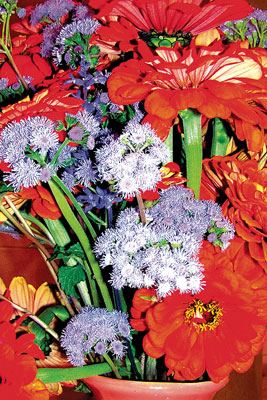 |
| Linda Mercer described ageratum as a “workhorse plant” in bouquets. This bouquet displayed in the Exhibition Hall at the Common Ground Country Fair, combines zinnias and ageratum. English photo. |
Adding Value Through Bouquets, Arrangements and More
By Dr. Lois Berg Stack and Jean English
Linda and Jim Mercer of Sheepscot Flower Farm in Newcastle, Maine (www.sheepscotflowerfarm.com), and Dr. Lois Berg Stack of the University of Maine talked about cut flower production and sales at the 2009 Farmer-to-Farmer Conference in Northport, cosponsored by MOFGA and the University of Maine Cooperative Extension.
The Mercers started growing cut flowers in 1997 and now grow 2 acres of the crop. They are active members of the international Association of Specialty Cut Flower Growers (https://ascfg.org), attending its annual meetings, receiving its quarterly magazine and trialing some new cultivars for the association.
Greenhouse Cut Flower Production
Sheepscot Flower Farm has three production greenhouses for cut flowers, each 50 feet long, with one heated for early season crops. They also have their original 12- x 16-foot hoophouse, in which they raise basil and salad mixes for themselves.
One of the larger houses, “the herb house,” has a Modine heater to allow for early production of potted herbs, hanging baskets and vegetable and flower seedlings, which bring income in spring before the cut flowers bloom. The other two house specialty cut flowers.
The Mercers start most of their seeds (buying just a few perennial and herb plugs) in January under fluorescent lights in a study in their house, in 128 and 288 plug trays set on wooden racks. They water the seedlings in their kitchen sink and move seedlings to the heated greenhouse in mid-March, to transplant and to grow on in the greenhouse soil. Their greenhouses have 2 x 12 frames around them to hold added soil.
For irrigation they fill blue barrels in greenhouses with water so that it warms. A submersible pump in the barrels connects to drip irrigation on the greenhouse beds.
They fertilize seedlings with Miracle-Gro, and they amend soil in their beds with llama manure compost. (See below.) No other nutrients are added to the soil. (They are not organic but, says Jim, “we’re awful close.”)
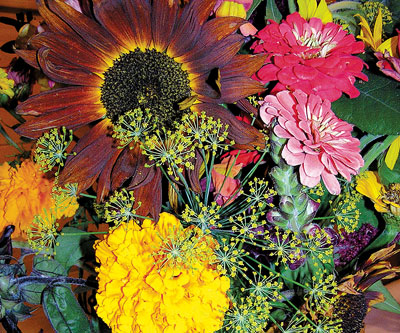 |
| A full bouquet of sunflowers, zinnias, marigolds and dill at the Common Ground Country Fair Exhibition Hall. English photo. |
Greenhouse Crops
Asiatic and Oriental lilies – among their biggest crops – are started in one of the two bigger, unheated greenhouses, in plastic crates that the bulbs come in, because the soil in the ground is too cold in the spring. They place about 3 inches of potting soil in each crate, set about 25 Asiatic or 20 Oriental bulbs on the soil and then cover them with more soil. They plant lilies every two weeks from mid-March to late June, producing cut flowers until late September or early October.
Lily flowers are picked before the buds open to avoid damage during transport. “You have to train your customers to buy them unopened,” said Linda. “They will open, and [customers] learn that pretty quickly. The get so they won’t buy lilies that are open.”
The lily leaf beetle is not a problem because their crop is grown under cover. Stack noted that for lilies growing outdoors, growers should begin scouting shortly before lilies begin to emerge in spring, by looking for the adults in the litter or mulch.
“There is only one generation per year, so if you eliminate the adults in the early part of the season, you’ve gone a long way toward controlling the population. Then try to rub off the small, yellow clusters of eggs when you see them on the undersides of leaves; remove the larvae when they’re young.” Bt products do not work well against this pest; spinosad products do. Asiatics are generally more susceptible than Orientals. Three of the cultivars of lilies that were tested at UMaine, ‘Uchida,’ ‘Black Beauty’ and ‘Madame Butterfly,’ showed some resistance to lily leaf beetle feeding damage. Daylilies (Hemerocallis species) are not bothered by the lily leaf beetle, which breeds and lays eggs on true lilies (Lilium species) and on fritillaria; they will feed on Solomon’s seal, flowering tobacco and eggplant, but don’t reproduce on these.
‘Karma’ dahlias, which have long stems, are grown from plugs (tiny plants, which provide a head start) and are transplanted into pots in a heated greenhouse in mid- to late March. They grow there for about four weeks, then are moved to one of the unheated houses in April. They get 6 to 7 feet tall and need to be supported with horizontal netting so that they don’t fall over. In fact, the Mercers use two or three layers of netting to support everything grown in their greenhouses except lilies.
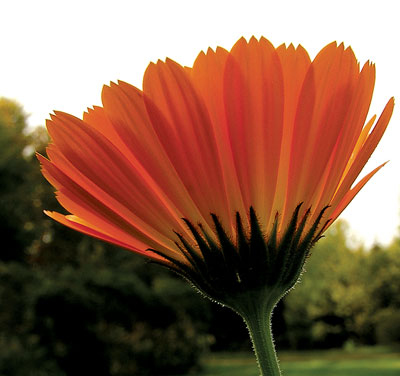 |
| Calendulas have a long season of bloom and are beautiful in bouquets, but they don’t last long as cut flowers. English photo. |
Sweet peas get as tall as the greenhouse (and are also grown outdoors) and produce well into fall.
Anemones are a good cool-season crop in the greenhouse.
Sunflowers are sometimes grown in the greenhouse for an earlier crop, to lengthen the cutting season.
Gerbera plugs are set in small pots and then transplanted in May to 2-gallon pots; they can develop powdery mildew.
Stock is a good cool-weather flower that does well in the unheated greenhouse.
Delphiniums are perennials; they’re easy to grow and flower early.
The Mercers also grow snapdragons; and they tried Ranunculus for two years, but these did not do well enough for them.
Outdoor Cut Flower Production
Some flowers that are grown outside are covered with fabric or plastic supported by hoops, to extend the growing season. The Mercers plant in 3-foot-wide beds.
Late-blooming French tulips, which flower in mid-May to early June, are their first spring crop. These are not a big money-maker, because the propagules are expensive, even in bulk; but they attract buyers early in the season. The Mercers grow half a dozen varieties, preferring the Parrot tulips.
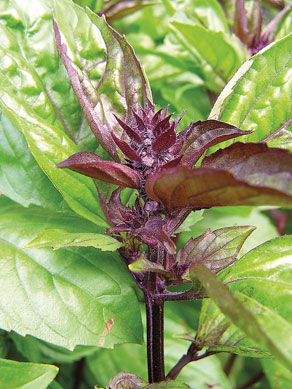 |
| With their deep green and purple foliage and their rich scent, different varieties of basil are welcome additions to bouquets. Shown here: Ocimum basilicum ‘Cinnamon.’ English photo. |
They grow about 200 peony plants, which bloom in June and are nice in bouquets with anemones (grown in and out of the greenhouse at Sheepscot). Peonies are “a very popular cut flower. People love them and pay a good price for them,” said Linda.
Ageratum is a workhorse plant. “People don’t buy it by the stem much,” said Linda, “but it’s great in bouquets. I can’t do without it.” ‘Blue Horizon’ grows and looks best and has the best fragrance.
Calendula flowers in early summer, along with ageratum. It has a short vase life.
Ammi majus (florists’ Queen Anne’s lace), a good filler, is daintier that the wild type and is prolific during its short season.
Golden dill is a great, long-lasting filler.
Panicum ‘Frosted Explosion’ is a good grass for arrangements.
Basil ‘Cardinal’ has green leaves, purple flowers and a wonderful scent.
Zinnias are another workhorse flower. The Mercers grow mostly the Benary’s ‘Giant’ series – which have just gone up in price – in separate colors rather than a mix. Johnny’s ‘Giant Dahlia Mix’ is less expensive and is also available in separate colors; the Mercers will try them this year. They’ve been growing four rows per bed but may cut back to three to improve air circulation. Stack noted that zinnias grown close together will grow taller, which is desirable for cut flowers, but greater planting distance will help minimize mildew. She also noted that growing in a greenhouse or hoophouse can help avoid one-sided zinnias, caused by tarnished plant bug feeding.
Cosmos ‘Versailles Mix’ produces flowers until frost.
The Mercers grow 1/4 to 1/2 acre of sunflowers; their favorites are ‘Sunbright Supreme,’ ‘Teddy Bear,’ ‘Double Quick,’ ‘ProCut’ and ‘Premier Lemon.’
Salvia horminum ‘Marble Arch Rose’ and ‘Marble Arch White’ are good mixed into bouquets.
China aster ‘Matador Mix’ is grown under row covers on hoops because it is susceptible to aster yellows, a disease spread by leafhoppers.
Euphorbia marginata ‘Kilimanjaro’ or snow-on-the-mountain is another pretty flower. Its milky sap can burn, so cut the stems carefully, don’t get the sap in your eyes, and tell customers to be careful when recutting stems.
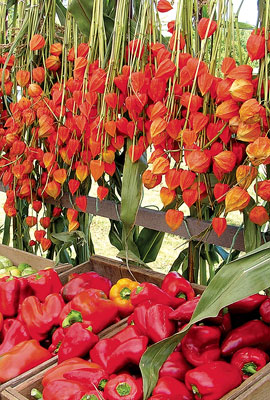 |
| Chinese lanterns are popular in bouquets and can even be displayed with vegetables to add color to a produce stand – as as this stand at the Common Ground Country Fair farmers’ market. The plants can be somewhat invasive in a garden, though. English photo. |
Celosia ‘Hi-Z’ is wonderful. The Mercers also grow various ‘Cristata’ types but never get very big heads. Still, they’re nice for fall color.
Rudbeckia ‘Indian Summer’ is prolific, with large flowers appearing in late summer and early fall. They grow it as an annual.
Dianthus ‘Amazon Rose Magic’ and ‘Neon’ have a light fragrance and are tall.
Lisianthus is started from seed in February and produces long-lasting blooms in late summer. The Mercers grow this outdoors due to a lack of greenhouse space; and it did not mature much earlier when grown in the greenhouse. They may try growing it under row covers.
Gladiolus is easy to grow.
Asclepias ‘Silky’ series of butterfly weed comes in three colors of long-lasting blooms, and Monarch butterflies love them.
Amaranthus ‘Copperhead’ and ‘Hot Biscuits’ have some 6-foot-tall plants with heavy stalks.
Acidanthera is fragrant and late.
Chinese lanterns are late. They can become weedy, so site them carefully.
Sales
The Mercers sell at five farmers’ markets: Bath, Damariscotta, Boothbay Harbor and twice weekly at Camden. They transport flowers in two vans that have shelves for trays of plants on one side and space for buckets on the other.
They originally sold bouquets and spent a lot of time making them but now sell solid bunches or single stems – with less work. Sometimes Linda makes a few bouquets for the market or at the market, which helps sell flowers; and Jim often makes a large arrangement in a vase and puts a price on it, such as $35. “By doing that,” he said, “I’m showing them how and what they might create with the flowers we brought to market that day.”
They set buckets of flowers on tables and on the ground around the tables, and customers help themselves and make their own bouquets in their own vases – sometimes spending an hour making a single bouquet.
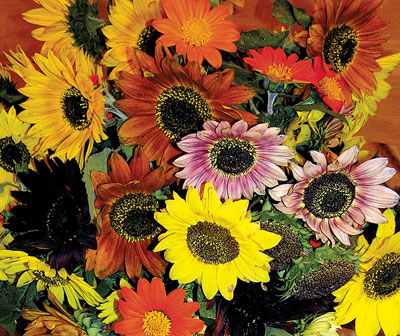 |
| Sunflowers are among the “easy, high-value, big-impact flowers” that Lois Berg Stack recommended. Two others that are sure to sell, she said, are lisianthus and exotic zinnias. This bouquet of sunflowers and ‘Torch’ Mexican sunflowers was grown and arranged by students at the Troy Howard Middle School in Belfast and displayed at the Common Ground Fair. English photo. |
“A nice marketing technique that we say we’re going to do every year but we don’t,” said Linda, “is making a bouquet-of-the-week. Have that bouquet made up, and have the buckets with the flowers that go into it around it, and people can see that and pick out the flowers.”
Pricing depends on the variety of flower. Bouquets sell for about $8 each, although prices vary somewhat by market. Prices are posted on both sides of flower buckets. The Mercers check wholesale prices for the Boston market at www.marketnews.usda.gov/portal/fv for reference, “and then we just bump our prices up from there.”
The Mercers also sell by special orders, especially for weddings. People usually come to the farm a couple of weeks before the wedding to decide what they want, or they phone in their orders. The Mercers cut the flowers the day before the wedding, and customers pick them up at the farm. The Mercers’ Web site, a good marketing tool, lists flower availability week-by-week during the growing season and shows photos of available flowers.
Challenges
Challenges include weeds, consistently finding good workers, occasional equipment malfunctions and deer. To deter deer from their sunflower field, they installed low-voltage electric fencing about waist-high. When Jim first sets it out, he folds aluminum foil baited with peanut butter over the wire. The deer get a shock when they taste it and learn to avoid the area.
Stack noted that a lily grower in East Parsonsfield used to use a steam jenny – like a steam gun used in automotive cleaning – to sterilize soils to kill weed seeds and root rot fungi.
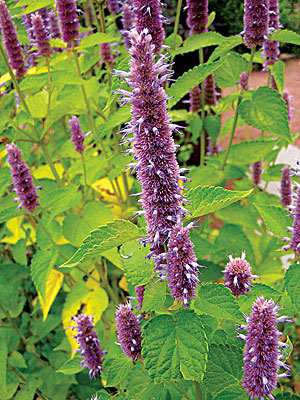 |
| Anise hyssop can be one ingredient in an edible bouquet that could also include dill, marjoram, basil, chives and other herbs, said Stack. Shown here: ‘Blue Giant’ hyssop, Agastache foeniculum. English photo. |
Innovations and Management Tips
A 60-llama herd nearby provides manure that is mixed with plant materials that were left over and composted at the end of the season. The manure and compost mix is added to garden beds inside and outside the greenhouses.
The Mercers apply the “pay-as-we-go” philosophy to business growth. They started with a 12- x 16-foot hoophouse made with PVC pipe before adding larger ones from Ledgewood Farm in New Hampshire (www.ledgewoodfarm.com); and moved from a Troy-Bilt rototiller to a 27 h.p. Kubota tractor with a good rototiller and a dump trailer that helps move materials. Now, “instead of getting bigger, we’re trying to get smarter.”
The 12- x 15-foot walk-in cooler they bought for a few hundred dollars at auction has made a big difference, alleviating the labor of carrying buckets of flowers to their basement to cool. The cooler can give them a two-week margin in the middle of the growing season when it’s hot outdoors. They built a flower shed around the cooler, so about half the shed is the cooler and the rest is work space.
Their golf cart is a huge time-saver and saves wear and tear on their arms and shoulders. They take customers to the fields in it; hook a small cart to it, put a bucket of water in the cart, and go around the beds cutting flowers and putting them directly in the water. The cart runs all year on about 5 gallons of gasoline. Golf carts are advertised in Uncle Henry’s.
To extend the season, they sometimes make wreaths.
To cut flower stems, they buy used blue-handled stainless steel chicken shears from Seawater Marina, 400 Old Causeway Road, Atlantic Beach NC 28512; 252-726-1637.
Twenty Tips for Cut Flowers
Dr. Lois Berg Stack presented these tips for flower growers in various situations.
Tips for vegetable growers who are considering selling cut flowers:
1. Flowers are often an impulse purchase. Try putting them near the cash register, because people are used to buying your vegetables and they don’t associate you with cut flowers yet. Stack showed a photo of boxes full of just celosia and zinnias. The flowers were sitting in Mason jars of water, and the wooden boxes held up the jars. “It’s a really easy way to transport flowers to the market without shattering them, and they’re already in those pre-sorted $5 bunches.”
2. Start with a few easy, high-value, big-impact flowers, such as sunflowers, lisianthus and exotic zinnias. “Those are three flowers that you will sell. And never sell a sunflower for less than 50 cents,” said Stack; $1 to $1.50 is more reasonable.
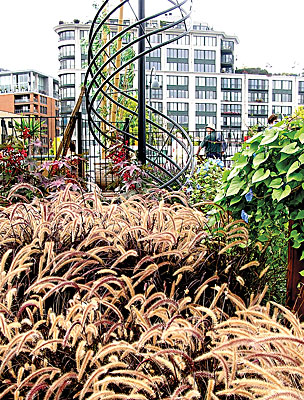 |
| Grasses, such as the fountain grass (Pennisetum alopecuroides) in the foreground of this landscape, can add a sense of movement to a bouquet. English photo. |
Tips for pick-your-own operations:
3. Provide what your customers need before they go to the field to pick: information (location of the field, prices), materials (containers, scissors) and advice (cut long stems, strip leaves off the lower half of the stems).
4. Set easy-to-understand prices. One grower provides 1-quart yogurt containers and lets customers fill it for $6; some customers cram 50 stems in the container. For a set price, you might sell as many flowers as fit into a paper cup cone with the bottom cut out, and set prices of high-value flowers individually. The fewer prices you have, the easier it is for you and for the customer.
Tips for using change to energize sales:
5. Offer unusual flowers, such as bicolor sunflowers or Armenian basket flowers (Centaurea macrocephala). The thistle-shaped flower head of Centaurea, a perennial, lends great texture to a bouquet.
Use changing themes to create interest. For example, “Bring flowers to a sick friend,” or “Celebrate Tuesday” or “Give yourself some flowers.”
Differentiate your business:
7. Shop at flea markets, garage sales and estate sales to find great containers at great prices. Your customers will love them.
8. Sell edible bouquets. Put dill, marjoram, basil, chives and other herbs in a vase, separately or as fillers. Stack had a bouquet including oregano and anise hyssop that lasted three weeks. Or be the person who gives a ribbon, cut to length, with every bouquet.
Apply the basics of design:
9. Always sell only the freshest flowers.
10. Harvest cut flowers in the early morning or early evening, and condition them to promote long vase life. Take the bucket of water to the field to get the flowers in water as soon as possible; cut the flowers, strip the leaves and put the flowers in water. Or cut them, put them in water, take them to the cool shed, and strip them and make bouquets. Cold water will keep the flowers younger longer – although, if you’re short on material for a market later in the week, you can put cut flowers in warm water so that they really start taking up water, and the warmth will help them develop faster. Likewise, leave them out overnight instead of putting them in the cooler to help them mature for the next day’s market.
11. Floral preservative helps cut flowers last longer, but fresh water (changed daily) is the most important factor in extending vase life. No floral preservatives are approved for organic growers. Use clean containers, too.
12. Add movement to your bouquets by adding plant material that has lines that extend beyond the bulk of the bouquet. Try adding grasses (oats, wheat, native grasses, which are easy to grow) or other flexible, arching plant parts (garlic scapes, ferns, Siberian iris leaves). These also make your arrangements look bigger.
13. Group small flowers into clusters that are about the same size as big flowers when designing bouquets that contain both large and small flowers. It’s a lot faster to grab a clump of small flowers and put it in a bouquet, and it makes it easier to distribute the color across the arrangement.
14. Let color work for you. Make striking combinations by staying with cool colors – blues/violets/greens – or with warm colors – reds/oranges/pinks/yellows.
15. Foliage (hosta leaves, peony foliage, ferns…) can hide bare stems, embellish and complement flowers, fill gaps, add texture and enrich a design, and increase the perceived value at the point of sale.
16. Make arrangements look larger than they are. Add space. Don’t crowd flowers; spacing them enhances their form.
17. Add white flowers to arrangements to make other colors stand out.
18. If your community values a favorite flower, grow it!
19. Find out what customers want by chatting with them, or shopping around, or doing a survey.
20. Supply care tags. They transform your customers into partners so that their bouquets last long enough that they perceive them as a good value but short enough that they’ll be back for another bouquet at the next market. A care tag might read, for example:
Discussion (moderated by Dr. Becky Sideman)
Wholesale
Dealing with florists is a business unto itself; it needs to be developed to be successful.
Wholesaling, which is built on relationships, may be easier in more rural areas that are distant from brokers. Shipping flowers by FedEx or UPS, in florists’ boxes, may be cheaper than delivering them yourself.
Organizing product consistency and availability for the wholesale market can be challenging.
Possible crops for wholesaling include dahlias, which don’t ship well from afar and will sell for up to $2 each with a long stem and an additional bud at the top as a design feature; delphiniums, which are expensive to ship, because they have to be shipped upright; alstroemeria, which would need to be grown in a marginally heated greenhouse in Maine; it drops a lot of its leaves in shipping; and lisianthus.
Seed Sources
Sources mentioned are not meant as endorsements, but as starting points:
Johnny’s Selected Seeds (cut flower seeds): www.johnnyseeds.com ; 1-877-564-6697
Fred C. Gloeckner (company brokers most floricultural crops): www.fredgloeckner.com
Maine field representative: Robin Patterson, Benton, Maine; 207-540-3793
Germania (annual and perennial plugs and plants): www.germaniaseed.com ; 1-800-380-4721
Thompson and Morgan (perennial plant seeds – generally for retail customers and in small quantities, but the photos in the catalog offer a good way to learn about perennials): www.tmseeds.com ; 1-800-274-7333
Ednie Flower Bulb (bulbs): www.ednieflowerbulb.com ; 1-800-244-4643
Fedco (seeds, bulbs): www.fedcoseeds.com ; 207-873-7333
BulbMark (bulbs, perennials): www.bulbmark.com ; 1-800-868-0426
Pleasant View Gardens (perennial and herb plugs): www.pvg.com ; 603-435-8361
Green Leaf Plants (formerly Yoder Bros.; perennials, herbs): www.glplants.com ; 1-800-321-9573
North Creek Nurseries (perennial plant plugs): www.northcreeknurseries.com ; 610-255-0100
Organic plugs: Stack couldn’t locate sources of organic cut flower plugs. If you find any, please let us know.
Best Crops
Check the references at the end of this article for ideas; several of the Web references have lists.
Innovations and Hints
Johnny’s Selected Seeds sells a Quick Hoops pipe bender that makes metal hoops for row covers. Metal hoops should hold up better than PVC hoops.
For market sales, wrap cut stems in a wet paper towel and put them into a tall plastic bag (newspaper bags are especially useful) to help them survive the trip home. Tell customers to recut stems a couple of inches once they get home, put the flowers in warm water, and put the whole bucket in the refrigerator to revive the flowers.
CoolBot, an air-conditioner-based do-it-yourself cooler, is available at https://storeitcold.com. See also “The CoolBot: The Small Farmer’s Answer to Cold Storage,” by Phil Norris, in the June-August 2009 issue of The Maine Organic Farmer & Gardener, at www.mofga.org/LinkClick.aspx?link=1189&tabid=1186
On hot days, Jim Mercer sometimes buys bags of ice to put in the 5-gallon buckets with the flowers.
Nematodes are useful for controlling Japanese beetles: See https://greenmethods.com ; 603-942-8932
Lily leaf beetle information is available at www.extension.umaine.edu/onlinepubs/htmpubs/2450.htm
Postharvest Care
“Bent neck” in zinnia, apparently caused by early harvest, can be prevented by harvesting after the green color at center of the flower is gone and pollen is starting to show; be sure to water the flowers immediately after harvest.
Place cut stems of zinnias in an acidic solution to improve their hydration, and place them in a cool location. They can be stored at 36 to 38 F for five days without deterioration of quality.
Flowers harvested in summer have a longer vase life than those harvested in fall.
Lilac flowers should be cut when they’re just starting to open; the stems keep for three to five days.
Dahlia vase life varies from 8.5 (with no cold storage) to 6.6 days (stored at 34 F).
Always cut with clippers that have a scissors action rather than those with an anvil, which will crush the stems. Make sure the blades are sharp.
Cutting flowers at an angle makes no difference in postharvest life. Stems have the same number of xylem tubes, whether cut straight or at an angle.
Resources
Web sites
Association of Specialty Cut Flower Growers, https://ascfg.org. The association has an online bulletin board for questions and answers, and much more.
ATTRA (Appropriate Technology Transfer for Rural Areas), www.attra.org, has online cut flower publications, including:
“Woody ornamentals for cut flower growers,” https://attra.ncat.org/attra-pub/woodyornamentals.html
“Specialty cut flower production and marketing,” https://attra.ncat.org/attra-pub/PDF/cutflower.pdf
“Edible flowers,” https://attra.ncat.org/attra-pub/PDF/edibleflowers.pdf
“Market gardening: a startup guide,” https://attra.ncat.org/attra-pub/marketgardening.html
SARE (Sustainable Agriculture Research and Education) provides information and sponsors research and education projects done by universities and growers, www.sare.org
Alan Stevens’ 33-page “Specialty Cut Flowers: A Commercial Growers Guide,” www.ksre.ksu.edu/library/hort2/MF1034.PDF
Publications
Armitage, Allan, 1993. Specialty Cut Flowers. Timber Press, Portland, Oregon. Available from ascfg.org
Arnosky, Frank and Pamela, 1999. We’re Gonna Be Rich! GFM Books, PO Box 3747, Lawrence, KS 66046; 800-307-8949. Four years’ worth of monthly columns from Growing for Market, focusing on the Arnoskys’ vast experiences in raising cut flowers.
Byczynski, Lynn, 1997. The Flower Farmer: An Organic Grower’s Guide to Raising and Selling Cut Flowers. Chelsea Green. Available from ascfg.org
Commercial Cooling of Fruits, Vegetables and Flowers, 1998. University of California Postharvest Outreach Program. Available from the Div. of Agriculture and Natural Resources Communication Svcs., UC, 6701 San Pablo Ave., Oakland, CA 94608; 510-642-2431.
Kieft’s Growing Manual for Annual, Biennial and Perennial Cutflowers and Ornamental Grasses Grown from Seed. 1989. Kieft Bloemzaden, Blokker, Holland. Available from ascfg.org
Nowak, Joanna and Ryszard M. Rudnicki, 1990. Postharvest Handling and Storage of Cut Flowers, Florist Greens, and Potted Plants. Timber Press, Portland, Oregon. Out of print; check used bookstores or obtain through interlibrary loan.
Ogden, Shepherd, 1995. Step by Step Organic Flower Gardening. HarperCollins, New York. Available from The Cook’s Garden, P.O. Box 535, Londonderry, VT 05148; 800-457-9703.
Rogers, Barbara R., 1988. The Encyclopedia of Everlastings: The Complete Guide to Growing, Preserving, and Arranging Dried Flowers. Weidenfeld & Nicolson, New York. Out of print; check used bookstores or obtain through interlibrary loan.
Sturdivant, Lee, 1992. Flowers for Sale. San Juan Naturals, Friday Harbor, Washington. Available from San Juan Naturals, P.O. Box 642A, Friday Harbor, WA 98250; 360-378-2648.
Thorpe, Patricia, 1986. Everlastings: The Complete Book of Dried Flowers. Houghton Mifflin, 181 Ballardvale St., Wilmington, MA 01857; 800-225-3362
Dr. Lois Berg Stack is Cooperative Extension Specialist, Ornamental Horticulture, and Professor of Sustainable Agriculture, University of Maine. You may contact her at 495 College Ave., Orono ME 04473-1294; Phone: 207-581-2949; Cell phone: 207-356-2890; Fax: 207-581-1301.
